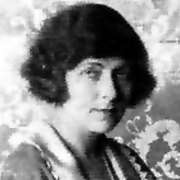
Hilda Hayward
Hilda Hayward was born in Takapuna on 26 September 1898, the daughter of an affluent engineer father and a music teacher mother. Her father drowned while Hilda was still a child.
Later she spoke of having been “intensely interested” in movies as a youngster — imagining herself not as an actor, but working behind-the-scenes.
In 1922 Hilda met Rudall Hayward, a young filmmaker who that year completed his debut feature, melodrama My Lady of the Cave. The couple married the following year. Rudall was an ambitious and prolific filmmaker, and they would go on to work on five features together over the next 14 years, plus more than 20 short films.
The Haywards soon made their home in the household of Hilda’s mother, where they installed a darkroom. As Deborah Shepard writes in her New Zealand film history Reframing Women, "Hilda learnt how to develop and edit film, often working way into the night to complete projects". When Hilda went away on location, her mother and grandmother were able to look after her daughter Philippa, who was born in 1924.
Hilda’s contributions to Hayward’s movies were many; some creative, and some managerial. Aside from editing, she managed finances, ordered film stock, helped find actors, and worked on costumes and make-up. According to son-in-law Neill Boak, she also had an eye for picking good locations; and her photographic skills were channelled into the photographs used to publicise Rudall’s movies.
After co-editing the first version of Rewi’s Last Stand with Rudall, Hilda edited and processed the footage for his follow-up, 1927’s The Te Kooti Trail. The film is based on an attack which occured during the military campaign of legendary Māori leader Te Kooti.
In the book New Zealand Film 1912-1996, film writer Sam Edwards calls Te Kooti New Zealand’s first significant docudrama. Edwards praises Rudall Hayward’s storytelling and camera work, adding that "much of the credit must also go to his first wife Hilda, who was instrumental in editing, and therefore constructing the subtleties of the narrative".
Hilda also edited follow-up film The Bush Cinderella (1928), one of Rudall’s biggest successes, and 1936 sound movie On the Friendly Road. The period between the two films witnessed major change, with the arrival of talkies slowing local feature film production to a crawl. Kiwi filmmakers set about creating their own homemade sound cameras to meet the challenge: the first to (separately) succeed were Ted Coubray and Rudall Hayward — Hayward working alongside Jack Baxendale and Hilda’s brother, engineer Armitage Moren.
Meanwhile the Haywards were travelling around New Zealand towns, pumping out a series of comedic silent shorts. The films featured a stock story shot on location, then rush-released under titles like A Daughter of Hastings, or Winifred of Wanganui. (Peter Jackson and Costa Botes’ mock-doco Forgotten Silver pays tribute to these 'community comedies’). Hilda’s job was usually to arrive in town in advance and start preparations, including casting the many locals who appeared on-screen — a job she did not enjoy.
She also took an acting role in 1927 short A Takapuna Scandal; dressed in a hat and glasses, she is seen on a rollercoaster and trying to rescue comedian Hector St Clair, after he floats up into the sky under an umbrella.
In 1932 Hilda took footage of the Auckland riots, though she may have filmed items before this date. Deborah Shepard writes that "in filming this historic event in 1932 she became New Zealand’s first known camerawoman".
The Haywards’ relationship ended after Rudall fell for Ramai Te Miha, the star of his 1940 version of Rewi’s Last Stand. Rudall and Ramai later married. Hilda made no more films, though she later managed a cinema in Avondale.
Hilda was rarely given on-screen credits, and in some of his later interviews Rudall neglected to mention her contributions to his career. Hilda died on 3 January 1970. Were it not for the efforts of Film Archive founder Jonathan Dennis and author Deborah Shepard, her part in New Zealand’s early filmmaking history might well have been forgotten.
Profile written by Ian Pryor; updated on 25 March 2022
Sources include
Helen Martin and Sam Edwards, New Zealand Film 1912 - 1996 (Auckland: Oxford University Press, 1997)
Diane Pivac, 'New Zealand film pioneer: Hilda Maud Hayward 1898 - 1970' Screening the Past issue 40, September 2015
Deborah Shepard. reframing Women - a history of New Zealand film (Auckland: HarperCollinsPublishers, 2000)
Deborah Shepard, ‘Shadow Play - The filmmaking partnership of Rudall & Ramai Hayward’ in Between the Lives - Partners in Art. Editor Deborah Shepard (Auckland University Press, 2005)